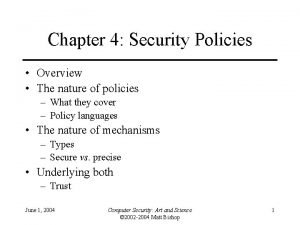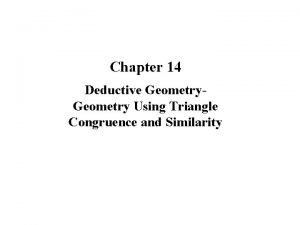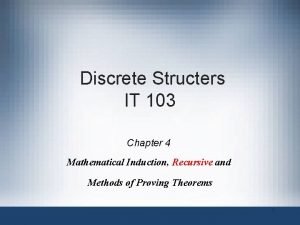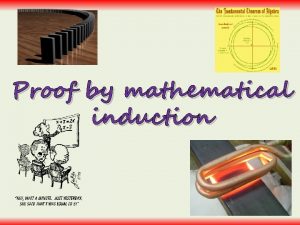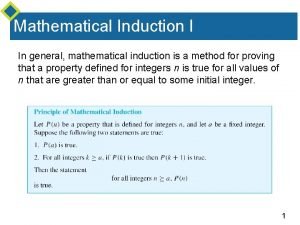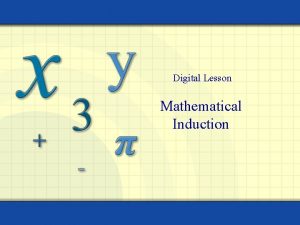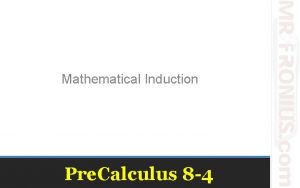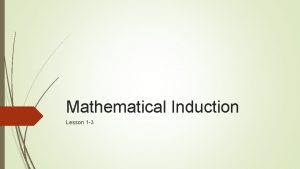Mathematical Induction Induction is the most important proof











- Slides: 11

Mathematical Induction. • Induction is the most important proof method in computer science. • Suppose you want to prove that the proposition P (n) is true for all n N, where N = {0, 1, 2, …} (an infinite set). ( i. e. every natural number n has some property P) • You might be able to prove it for 0, 1, 2, … But you can’t check one-by-one that all natural numbers have property P.

• The key idea of mathematical induction is start with 0 and repeatedly add 1. • Suppose you can show that i) 0 has property P and ii) whenever you add 1 to a number that has property P the resulting number also has property P. This guarantees that as you go through the list of all natural numbers, every number you encounter must have property P.

• The proof method of mathematical induction says that you just need to do two things: i) prove it for n = 0 (basis case) ii) prove “if it’s true for n=k, then it’s true for n =k+1” Induction Hypothesis • fix some k 0 • assume P (k) Induction Step • Using assumption P (k) prove that P (k+1) In this way we prove that for any n [P(n) P(n+1)]

Why does this prove it for all n N ? Actually it relies upon the property of integers N={0, 1, 2, …} The pattern is: To prove n 0 (P (n)) it’s enough to show: 1) (Base) P (0) 2) n 0 (P(n) P (n +1)) How can we prove n 0 (P(n) P (n +1)) ? Pick arbitrary k 0 and prove it for n = k. So, in the second step we say: “take some k 0 and assume that property P holds for n = k“ (Induction Hypothesis). Then, (based upon this assumption) we need to show that the property P can be implied for n = k +1.

There is a variant if you want to prove it for n n 0 : To prove n n 0 (P (n)) it’s enough to show: 1) (Base) P ( n 0) 2) n n 0 (P(n) P (n +1)) 1) In the base case we explicitly check n = n 0 2) Pick arbitrary k n 0 and assume that the property P holds for n = k. (Induction Hypothesis) Based upon this assumption prove that the property P can be implied for n = k +1. (Induction Step)

Example. Prove that for all n 1 n! 2 n 1. Proof by induction on n 1. 1). Basis: n =1. 1!=1=21 1=20. So, for the case n=1, we checked that n! 2 n 1. 2). Assume that for n=k, k is some integer k 1, inequality holds, i. e. k! 2 k 1 (IH). We want to prove that n! 2 n 1 for n = k +1, i. e. we want to show that (k+1)! 2(k+1) 1 Using the definition of factorial we have (k+1)!= (k+1) k! (k+1) 2 k 1 ……by IH (1+1) 2 k 1 ……because k 1 = 2 2 k 1 = 2 k……QED, because 2(k+1) 1= 2 k By Induction Principle we conclude that n! 2 n 1 for all n 1

Induction proof for the summation formula Let’s prove the formula for the sum of integers from 1 to n: n 0 P (n) Alternative notation for the LHS: Thus we want to prove: n 0

Let’s stop for a moment and check that the formula we are to prove makes sense: n 0 Consider a few particular cases: • n =1 • n=0

In accordance with induction pattern: 1) (Base) P (0) 2) n 0 (P(n) P (n +1)) P (n) here is the predicate: Prove: n 0 • (Base) • (Inductive step) n 0 P (n) P (n+1)

1) Basis: check that the formula is correct for the case of no terms 2) fix some k 0 and assume that proposition holds for n = k P(n=k) (induction hypothesis, IH) Show that the P(n=k+1): can be implied (IS) ……. . by IH …. algebra

Why induction proofs work? Intuitively, because we can reach any number n if we start with the smallest one and add 1 step-by-step. So, induction principle express this obvious fact. More formally, induction principle is formulated in terms of a set A = {n N | P (n)} Induction Principle. If A is a subset of N that satisfies two properties: 1) 0 A 2) n 0 [n A (n+1) A], then A =N
 Natural numbers definition and examples
Natural numbers definition and examples Example of existential universal statement
Example of existential universal statement Example of a news story
Example of a news story Inverted pyramid in news writing
Inverted pyramid in news writing Least important to most important
Least important to most important Elements of mathematical economics
Elements of mathematical economics Mathematical proof
Mathematical proof Mathematical proof
Mathematical proof Mathematical induction
Mathematical induction Proof by induction
Proof by induction Eecs 203
Eecs 203 Mathematical induction
Mathematical induction






